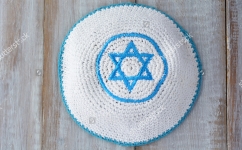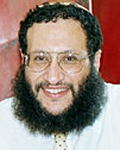 |
 |
 |
|||||
|
By Mottel Baleston Two Shofars ago, another article by Mottel appeared: "The Abrahamic Covenant: The Basis for Jewish Identity." By sheer coincidence (?), we are now presenting this article by Mottel that also has to do with Jewish identity; only the Abrahamic Covenant is the biblical, rock-solid basis that will last for eternity, but the kippah (kee-PAH) . . . well, before I steal Mottel's thunder, let's turn the mic over to him. ~ editor ~
During the very first day of my summer of living and studying in Jerusalem, the capital of Israel, the great variety of my fellow Jews struck me. If you go back far enough, we all originated from Israel, the Holy Land, but centuries of wandering in the Diaspora influenced our appearance. There were many light-skinned Jews like myself whose ancestors had spent a thousand years in Eastern Europe. There were other Jews who had never left the Middle East, the Iraqi and Syrian Mizrachi Jews who operated the fruit stands near my Jerusalem neighborhood. There were olive-skinned Yemenite Jews who had lived almost unchanged from biblical times in an enclave of the Arabian Peninsula until the 1950ís, as well as recently arrived Ethiopian Jews who were even darker. There were Jews who were tall, Jews who were short, some who were wealthy, and a surprising number who lived in poverty. One item that many of them had in common was the wearing of a kippah, a small head covering for men who are religious Jews. Known in English as a skullcap, the Yiddish term "yarmulke" is what I grew up with as a boy in my Jewish neighborhood in New York City. As kids we knew that whenever we walked into the synagogue we needed to wear a kippah. For convenience, the synagogue would have a box of inexpensive kippot (kee-POTE, plural) just inside the door for those who arrived without their own. The kippah is worn at all times by Orthodox Jewish men and boys, and during any sort of religious service by all other men who are not religious. In recent years, there has been a small movement to wear kippot among feminist women active in more liberal Jewish circles. Thus, it is common to see female rabbis in both the Reform and Conservative Jewish movements wearing them while conducting religious services. The small size and round design of the kippah is no more than several hundred years old. Older illustrations of religious Jewish men show a wide variety of headgear. Modern designs vary. Some are very colorful and large, covering most of the head. An example of this is the Bukharan kippah. The strictly Orthodox make sure that their skullcap is large, black, and solid, while the modern Orthodox are often known as the "Knit Kippah" faction. In recent years, the Orthodox movement has permitted young boys to have cartoon, sports team, or pop-culture designs on their kippot, and so it should not surprise us to see a Superman logo painted on a leather kippah. If you were to ask knowledgeable Jewish rabbis to explain the motivation for wearing a kippah, the answers would all center on two factors: the belief that wearing a head covering shows awe and respect before an almighty God, and the idea that the kippah is a universal symbol of Jewish men to identify with their community. Thus, the basic message a man sends when he wears a kippah is that he is religious and observant of the Jewish Scriptures and traditions. Old Testament Head Coverings Still, some would persist and say that the high priestís head covering was a reminder of the holiness of God and our willingness to be submissive to it. They cite the fact that the brim of the turban had the words "Holy, Holy, Holy unto the Lord." Yet, if one looks at other Old Testament passages where a head covering is mentioned, the three most prominent refer to the act of covering oneís head as part of sadness and mourning. These are 2 Samuel 15:30, Jeremiah 14:3-4, and Esther 6:12. In essence, no strong case can be made from the Hebrew Scriptures for the wearing of a kippah. Talmud and Jewish Tradition
These examples and admonitions were not universal but personal, and if you spend enough time researching the Talmud, you will find a variety of practices. For example, the Vilna Gaon, a revered Jewish sage who lived from 1720-1797, said that one can pronounce the formal Hebrew prayer before a meal without a kippah, since wearing a kippah is only an instance of having an "exemplary attribute." In other words, you were being very pious to wear one. (Footnote 1) It is clear that the practice of wearing a head covering, and not just during religious ceremonies, while originally a minhag (local custom), was becoming more and more a din (law) expected within Jewish circles as it contributed to a group identity and strengthened the community. From the Medieval Age through the Enlightenment, the Jewish people wore a wide variety of head coverings with a little resemblance to the small skullcaps of today. In some locations where government was influenced by large institutional churches, local edicts would be enacted as anti-Semitic measures to force Jews to wear certain types of identifying headgear. In some cases what was originally meant as an emblem of shame became in the eyes of the Jewish community a badge of honor as it showed their willingness to suffer at the hands of unjust government rather than converting to the prevailing form of apostate Christendom. A seismic shift within Judaism during the 1800s brought about the liberal Reform movement with its abandonment of many Jewish practices. Jews who saw themselves as full participants in a modern world stopped wearing the kippah daily. Today, while it is still worn by Orthodox Jewish men, all other Jewish factions will wear it only for religious occasions. New Testament Practice
Even among conservative evangelical scholars there are varied understandings of this passage. In connection with the subject of a manís head covering, several points could be made, though they may not be embraced by all: Some imagine that Paul is mandating a total change for their new Christian practice in order to differentiate it from Jewish practice. However, that view is weak because Paulís own reasoning is related to eternal theological truths, not those that were ushered in by the Dispensation of Grace. Secondly, Paul reminds the Corinthians that a woman ought to have an appropriate head covering at all times. That was exactly the practice the Jewish community already had, so there was no attempt to create a new doctrine or practice. The Greek phrase in verse 4 describing a manís head covering is translated in Vincent's Word Studies as "having something hanging down from his head". This rendering is supported by several other Greek studies. Obviously, this describes something far different than todayís skullcap. That Ďhanging downí appearance can be understood as either a full veil for mourning or a womanís style cloth head covering. It could also refer to very long natural hair on a man, obscuring his gender. Again, what is being described is something very different than a modern kippah. As a major theme of Corinthians is the gender distinction within creation and the New Testament congregation, there is good support for understanding the prohibition of verse 4 to apply to a man having an appearance like a woman and wearing that which "pertaineth" to a woman, something strongly condemned in the Torah. That possibility is reinforced by 1 Corinthians 11:14, which clearly states that a womanís length and style of hair when worn by a man is dishonoring to him. Again, the main issue is that of gender distinctions, something our modern world is in rebellion against, a foolish position which goes against Godís created order. New Covenant Grace
These verses remind us that we are not under law, but under grace. The prevailing evidence is that the Greek text of 1 Corinthians 11:4, 14 does not prohibit the wearing of a kippah but points out the shame of a man being a "gender bender." Additionally, 1 Corinthians 9 shows Paul participating in Jewish style and ritual, with all its garb and practice, not only to make his evangelism more acceptable but also because of personal preference as seen in Romans 14:5. The entire chapter of Romans 14 shows us that within our believing community there are going to be preferences regarding cultural practices, and that is not something to be worried about or campaigned against. If a Jewish believer in Yeshua covers his head, it does not mean he is going back under the law, nor has he "fallen from grace." Rather, wearing a kippah can open doors and be a powerful testimony as a number of newly saved Jewish believers have reported. During the 17 years I led or co-led a Messianic Jewish Congregation, I wore a kippah at every function and I gently encouraged other men to do the same thing. If some preferred not to wear one, OK, no pressure was put on them. Now, if I am guest speaking in a church setting where it is customary for men not to cover their heads in the service, I will certainly abide by that, putting aside my own customs in the interest of the community and fellowship described in Romans 14. By the same token, when Gentile believers walked into the messianic congregation I led for many years, they most often understood that we were sound and conservative in doctrine and that our wearing of the kippah was certainly not an issue. What about non-Jews wearing a kippah? It is fine as long as the believer does not imagine that wearing the kippah makes him a Jew. It also can be a positive testimony as long as sound, grace-centered doctrine is taught in the congregation. Let us not allow cultural preferences in music, apparel, or similar non-central issues divide us. Let us grant each other the same freedom in these areas that we want the Lord to grant us. Rather than imagining the worst about a fellow believerís motivation for wearing a kippah, let us praise the Lord for the fact that so many Jewish people are coming to a born-again, saving faith in Yeshua, our Jewish Messiah.
1. See
www.hakirah.org/Vol 4 Rabinowitz.pdf for a document tracing
the history of the kippah dispute within Judaism.
The Kippah
|
|||||||
